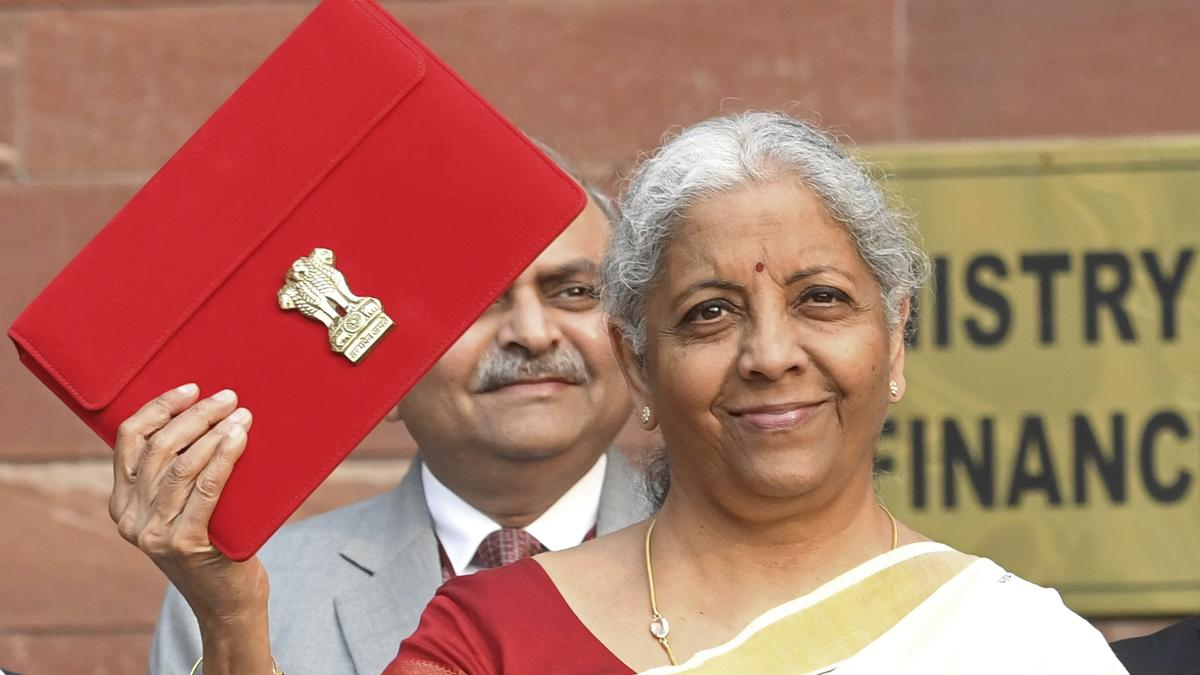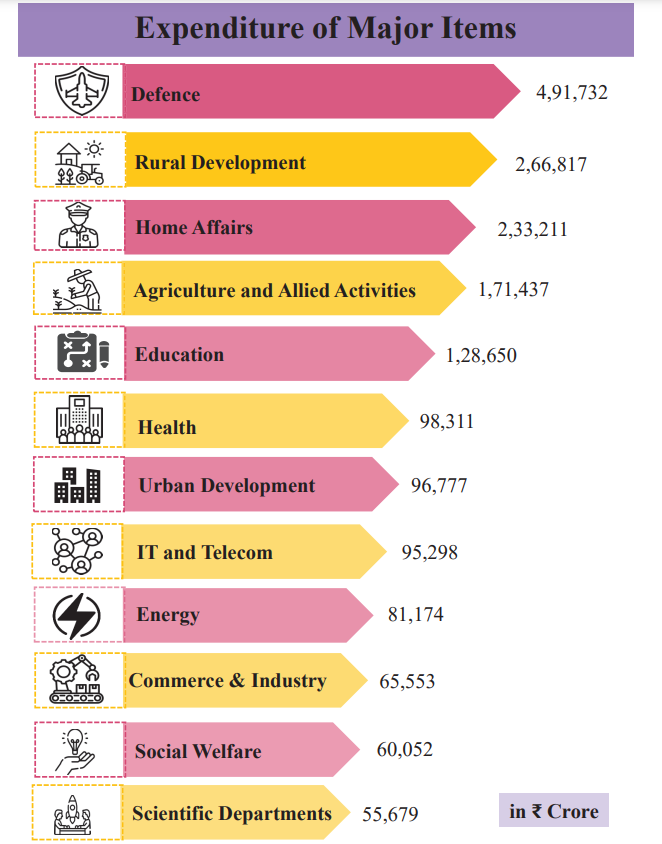The Finance Minister opened the Budget Session with this, "The great Telugu poet and playwright Gurajada Appa Rao had said, ‘Desamante Matti Kaadoi, Desamante Manushuloi’; meaning, ‘A country is not just its soil, a country is its people.’

Image ref: The Hindu
In line with this, for us, Viksit Bharat encompasses:
a) Zero-poverty;
b) Hundred percent good quality school education;
c) Access to high-quality, affordable, and comprehensive healthcare;
d) Hundred per cent skilled labour with meaningful employment;
e) Seventy per cent women in economic activities; and
f) Farmers making our country the ‘food basket of the world’. "
The Union Budget 2025, presented on 1st Feb 2025, is an important step in this direction, aiming to create a balanced, inclusive, and forward-thinking economy.
This year’s budget sets a clear vision for India's transformation into a developed nation by 2047.
It focuses on six key areas—poverty eradication, universal access to quality education, affordable healthcare, a skilled workforce, women’s economic empowerment, and a robust agricultural sector.
Let’s take an in-depth dip into the highlights and implications of Budget 2025 for various sectors.
1. Agriculture and Rural Development
India's agrarian economy receives a significant boost in Budget 2025 through well-structured schemes and financial support to farmers.
The Prime Minister Dhan-Dhaanya Krishi Yojana seeks to improve farmers' access to credit, irrigation, and storage while also revolutionising crop productivity.
The Mission for Aatmanirbharta in Pulses is a major step towards reducing reliance on imports by supporting farmers in growing high-demand pulses like Tur, Urad, and Masoor.
The government will extend the Jal Jeevan Mission to provide 100% tap water coverage in rural areas until 2028 in an effort to further support rural development.
Additionally, the Kisan Credit Card (KCC) expansion raises the loan limit from ₹3 lakh to ₹5 lakh, ensuring easier credit access for farmers.
2. Strengthening MSMEs and Entrepreneurship
Micro, Small, and Medium Enterprises (MSMEs) play a vital role in India’s economy, contributing 45% of India's exports and driving economic development.
Recognizing their importance, the government has revised the investment and turnover limits for MSME classification, increasing them to 2.5 times and 2 times, respectively, to accommodate growing businesses.
The announcement of increased credit availability, including a broader guarantee coverage for MSMEs, aims to bolster financial support. Additionally, the Credit Support for MSMEs introduces customized credit cards with a ₹5 lakh limit, ensuring easier access to capital for business growth.
The Entrepreneurship Scheme for First-Time Business Owners provides term loans up to ₹2 crore over the next five years, particularly benefiting women and individuals from Scheduled Castes (SC) and Scheduled Tribes (ST). This initiative aims to empower 5 lakh first-time entrepreneurs, fostering inclusive economic growth.
The government has started the following initiatives to strengthen the ‘Made in India’ campaign and increase domestic manufacturing:
- A scheme to make India a global hub for toys, promoting local production.
- A National Manufacturing Mission to support small, medium, and large industries, reinforcing the ‘Make in India’ vision.
These initiatives collectively enhance the growth and global competitiveness of India’s MSMEs, ensuring they remain the backbone of the economy.
3. Investment in Infrastructure, People, and Innovation
Investment in infrastructure remains a cornerstone of Budget 2025, with significant allocations for urban renewal, national asset monetization, and technological advancements.
With a ₹1 lakh crore investment, the Urban Challenge Fund will fund initiatives like "Cities as Growth Hubs", innovative city redevelopment, and water and sanitation upgrades.
Additionally, the Jal Jeevan Mission has been extended till 2028, ensuring a focus on quality, operations, and maintenance through Jan Bhagidari (community participation).
The National Asset Monetization Plan (2025-30), with a target of ₹10 lakh crore, will reinvest funds into new infrastructure projects, leveraging existing government assets to drive expansion. Moreover, ₹1.5 lakh crore has been allocated for 50-year interest-free loans to states, encouraging capital expenditure and reforms.
A substantial push towards transportation and connectivity is evident, with expanded railway corridors, expressways, and metro networks, facilitating smoother movement of goods and people.
Beyond infrastructure, Budget 2025 prioritizes investment in human capital with several forward-thinking initiatives:
- 50,000 Atal Tinkering Labs to be established in government schools over the next five years to foster innovation.
- Under the BharatNet initiative, all government secondary schools and rural primary health centres will have access to broadband.
- Bharatiya Bhasha Pustak Scheme, offering digital books in Indian languages for school and higher education.
- Five National Centres of Excellence for Skilling, developed in collaboration with global partners to strengthen India’s manufacturing sector under the ‘Make for India, Make for the World’ vision.
- A dedicated Centre of Excellence in AI for Education, with a ₹500 crore allocation, to integrate artificial intelligence into learning.
Recognizing the growing gig economy, the government is introducing identity cards, e-Shram portal registration, and healthcare benefits for gig workers under the PM Jan Arogya Yojana.
On the innovation front, a ₹20,000 crore fund has been allocated to boost private sector-led research and development. Major initiatives include:
- The National Geospatial Mission, which aims to improve urban planning data and geospatial infrastructure.
- The Gyan Bharatam Mission, focused on surveying, documenting, and preserving over 1 crore historical manuscripts.
- A National Digital Repository of Indian Knowledge Systems, ensuring access to and preservation of India’s vast intellectual heritage.
By investing in education, skilling, and innovation, the government is laying the foundation for a future-ready India.
4. Boosting Exports with Digital Infrastructure and Manufacturing Growth
The government is taking a big step toward enhancing exports and global trade opportunities for MSMEs through the Export Promotion Mission, a collaborative effort by the Commerce, MSME, and Finance Ministries.
To simplify trade processes, ‘BharatTradeNet’ (BTN) is being proposed as a unified digital public infrastructure that will streamline trade documentation and financing solutions, making cross-border transactions smoother.
On the manufacturing front, the government is focused on strengthening domestic production capabilities to seamlessly integrate with global supply chains.
Special emphasis is being placed on supporting India’s electronic equipment industry to harness the potential of Industry 4.0 technologies.
Additionally, a National Framework for Global Capability Centres (GCCs) is being developed, with a vision to position emerging Tier-2 cities as innovation hubs.
Recognizing the need for better logistics and storage, the government is also upgrading air cargo infrastructure and warehousing facilities, particularly for high-value perishable horticulture produce, ensuring smoother export operations.
With these initiatives, Budget 2025 lays the foundation for stronger export growth, a digital-first trade ecosystem, and a more globally competitive manufacturing sector.
5. Income Tax Reforms: A Big Win for the Middle Class
India’s middle class is the backbone of the country’s economy, and Budget 2025 brings major tax relief to ease their financial burden.
Over the years, the government has consistently reduced taxes—raising the nil-tax slab from ₹2.5 lakh in 2014 to ₹7 lakh in 2023.
Now, in a historic move, the tax-free income limit has been increased to ₹12 lakh under the new tax regime, ensuring that those earning up to ₹1 lakh per month pay zero income tax.
For salaried individuals, this limit extends to ₹12.75 lakh with a ₹75,000 standard deduction.
To further put more money in people’s hands, the government is revamping tax slabs to benefit all taxpayers.
Revised tax rate structure under the new tax regime:
| Month | Rate of Tax |
|---|---|
| ₹ 0 – 4 Lakh | NIL |
| ₹ 4 – 8 Lakh | 5% |
| ₹ 8 – 12 Lakh | 10% |
| ₹ 12 – 16 Lakh | 15% |
| ₹ 16 – 20 Lakh | 20% |
| ₹ 20 – 24 Lakh | 25% |
| Above ₹ 24 Lakh | 30% |
Additionally, a special rebate ensures that those earning up to ₹12 lakh pay zero tax, even after slab changes. This results in significant savings—for instance, someone earning ₹12 lakh will save ₹80,000, while an individual with an ₹18 lakh income will benefit by ₹70,000.
By reducing taxes, the government is encouraging higher household consumption, savings, and investments, ultimately fueling India’s economic growth.
6. Social Welfare and Women Empowerment
Empowering women and strengthening healthcare systems are at the heart of Budget 2025. Increased funding is allocated for rural health infrastructure, ensuring accessible medical facilities in underserved regions.
The integration of AI-driven medical diagnosis will improve healthcare efficiency and reduce response times in critical cases.
Women’s participation in the workforce is being encouraged through incentives for female-led startups, special credit facilities, and skill development programs tailored for women entrepreneurs.
Moreover, the Pradhan Mantri Awas Yojana (PMAY) has received additional funding to meet the rising demand for affordable housing.
7. Technology, AI, and Green Economy
Technological advancements and sustainability are key drivers of Budget 2025. The expansion of AI-driven public services will enhance governance efficiency, ensuring faster delivery of essential services.
To accelerate clean energy adoption, subsidies and incentives for Electric Vehicles (EVs) and Renewable Energy have been increased.
Additionally, a Climate Resilience Fund has been introduced, allocating resources for climate adaptation strategies and disaster preparedness, making India a global leader in sustainable development.
Budget 2025 is the Vision For Developed India by 2047

Image ref: India_Budget
The Union Budget 2025 is a strategic roadmap for India's economic shift. By prioritizing rural growth, infrastructure, technological innovation, and fiscal discipline, it sets the foundation for a robust and inclusive economy.
From empowering farmers and MSMEs to boosting digital education and AI adoption, the budget reflects a balanced approach to development. Reducing fiscal deficit and tax reforms provide financial stability while ensuring continued investments in key sectors.
As India moves towards its vision of a Developed Bharat by 2047, this budget marks a significant step in achieving long-term prosperity. The coming years will reveal its full impact, but for now, Budget 2025 lays the groundwork for a progressive and economically resilient India.
Also Read:
- Vyapar and Suvit Unite to Revolutionize B2B FinTech Solutions for MSMEs & Tax Professional Ecosystem
- What is a High Net Worth Individual in India? Meaning & Types
- The Best Accounting Software Options in India for 2025
- Top 10 Accounting Automation Tools in India
- Tax-Savvy Strategies for Indian Small Businesses: Must-Know Tips

















